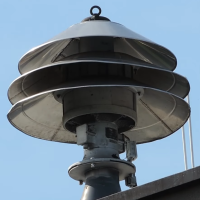Elektror L138
| Elektror L138 | |

| |
| Company | Elektror Karl W. Müller |
|---|---|
| Produced | 1939-1945 |
| Type | Omnidirectional Electromechanical |
| Horsepower | 1.35 hp |
| Voltage | 220 V 3 ph |
The L138 is a special purpose, dual motor, dual tone electric siren that was produced by Elektror Airsystems. Essentially two separate sirens mashed into one, the siren was designed to fill the role of two sirens at once. These sirens are very rare compared to other German mechanical sirens such as the E57 and Elektror's various other sirens. Currently, 11 units are known to still exist. Three are active, three are inactive, and five are in private possession. It was the "middle option" in Elektror's dual rotor siren series, with the Elektror L1/F2 being the large option.
History and design
The L138 was introduced sometime during 1939, designed as a unique dual-purpose siren which could fill the role of two sirens with only a single mount and power source needed. These sirens are essentially two Elektror S3B sirens combined into one, with both the ~500 Hz high tone ("Tweeter") and ~145 Hz low tone ("Woofer/Tiefton") rotor and stator variants of the S3B being used on the L138. The low tone is 3-port, while the high tone is 11-port. The siren makes use of two separate electric motors, similar to 1 ph Sentry sirens, which are 1 kW (1.35 hp) and run on 220 V 3 ph at 50 Hz. The siren was rated with a maximum range of 3-5 km (1.8-3 mi) after repeated tests, though in typical operation the siren was rated at roughly 250-500 m (820-1640.4 ft). The two rotors are designed to spin in opposite directions of one another, with rotation arrows included to show the correct direction, similar to ACA or Denver sirens.
Existing low-tone Elektror S3B sirens could easily be converted to L138 sirens by adding the high-tone S3B to it, which Elektror would do upon request. Both siren units are technically their own sirens and are designed to be operated either independently or simultaneously. In Germany, the low tone "Woofer" is typically used for fire calls at volunteer fire departments, while the high tone "Tweeter" is used for general alerts and danger. Both sirens operating at once in a wailing tone signaled an incoming air raid. However, today the dual siren operation is usually used for all purposes of surviving active units. The two siren units are bolted together in the middle of the siren, with the motors on the top and bottom of the siren. Because Elektror S3B sirens intake from below, where the motor is located, this meant the siren units could be directly bolted together with no room needed in between for air intake. Instead, the low tone intakes from below, while the high tone intakes from above. This greatly saved space.
Like many German sirens, the sirens intake from the same side as the motor. Mesh screens are included to protect the intakes and stator ports. The bottom motor has a stand attached, where the siren can be mounted from, while the upper motor has the eyebolt. 3 large skirts are included with the siren to project the sound. One acts as a rain shield, attached to the upper motor, while the two lower skirts project the sound from both siren units and shield them from the elements. The lower motor has two prominent wiring terminals attached: One is the main terminal where the wiring goes and directly powers the low-tone siren, while the other terminal is simply where the high-tone siren's wiring goes.
Unfortunately, the L138 did not prove to be as popular as many other sirens, especially compared to Elektror's other offerings, which led to its discontinuation in 1945. These sirens tend to have one siren fail, leaving only the other siren functioning, and due to having two siren units, twice the maintenance is required. They were also somewhat heavy, weighing in at 62 kg (136 lbs) with the skirts attached and 48 kg (105 lbs) without. As a result, many were taken out of service and scrapped. Today, only three sirens remain in service, while three others sit inactive and five survive in private ownership. Those who do run these sirens take great care of them, as their historical value and uniqueness are much appreciated.